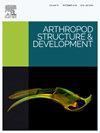The ultrastructure of sperm and the female storage organ in the backswimmer Notonecta glauca (Hemiptera: Notonectidae) and the coevolution of these two structures
IF 1.3
3区 农林科学
Q2 ENTOMOLOGY
引用次数: 0
Abstract
This study describes the coevolution of sperm length and female spermatheca size in the backswimmer Notonecta glauca. The species exhibits exceptionally long sperm, characterized by an unusually elongated acrosome, a short nucleus, and a long flagellum featuring a conventional 9 + 9+2 microtubular axoneme and two large mitochondrial derivatives. The spermatheca is equally elongated, comprising a spiralized proximal tract with a unique and novel ultrastructure, a long middle cuticular duct, and a terminal bulb. The spiralized region is lined by an epithelium covered with an extraordinarily thick cuticle composed of orthogonal pillars that terminate in pointed apices. In mated females, a thick secretion layer accumulates between the cuticle and the epithelium, which is enriched with mitochondrial complexes. A comparative analysis of virgin and mated females suggests that the epithelium in mated females actively reabsorbs fluid from the duct lumen. The cuticular duct, a simple and elongated tract, has its lumen compartmentalized by cuticular projections. The terminal bulb, in turn, features an epithelium made up of secretory cells with an extracellular cistern for secretion storage and duct-forming cells rich in longitudinal microtubules. These cells are equipped with ducts that transport the stored secretion to the lumen. Overall, the findings confirm that the size of the female spermatheca influences sperm morphology, underscoring a tight coevolution between these traits.
背游鱼(半翅目:背游鱼科)精子和雌性储存器官的超微结构及其共同进化。
本研究描述了背游鱼(Notonecta glauca)精子长度和雌性精子囊大小的共同进化。该物种表现出异常长的精子,其特征是异常细长的顶体,短的细胞核和长鞭毛,具有传统的9+ 9+2微管轴突和两个大的线粒体衍生物。精囊同样拉长,包括具有独特新颖超微结构的螺旋状近端束、长中间角质层管和顶球。螺旋区衬有上皮,上皮上覆盖着极厚的角质层,角质层由尖尖的正交柱组成。在交配的雌性中,角质层和上皮之间积累了一层厚厚的分泌层,其中富含线粒体复合物。一项对未交配雌性和交配雌性的比较分析表明,交配雌性的上皮积极地重新吸收来自管腔的液体。角质层导管是一个简单而细长的束,其管腔被角质层突起分隔开。而末梢球的特点是上皮由分泌细胞和富含纵向微管的导管形成细胞组成,这些细胞具有用于储存分泌物的细胞外池。这些细胞配备有导管,将储存的分泌物输送到管腔。总的来说,研究结果证实了女性精子囊的大小影响精子形态,强调了这些特征之间紧密的共同进化。
本文章由计算机程序翻译,如有差异,请以英文原文为准。
求助全文
约1分钟内获得全文
求助全文
来源期刊
CiteScore
3.50
自引率
10.00%
发文量
54
审稿时长
60 days
期刊介绍:
Arthropod Structure & Development is a Journal of Arthropod Structural Biology, Development, and Functional Morphology; it considers manuscripts that deal with micro- and neuroanatomy, development, biomechanics, organogenesis in particular under comparative and evolutionary aspects but not merely taxonomic papers. The aim of the journal is to publish papers in the areas of functional and comparative anatomy and development, with an emphasis on the role of cellular organization in organ function. The journal will also publish papers on organogenisis, embryonic and postembryonic development, and organ or tissue regeneration and repair. Manuscripts dealing with comparative and evolutionary aspects of microanatomy and development are encouraged.

 求助内容:
求助内容: 应助结果提醒方式:
应助结果提醒方式:


